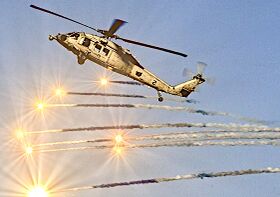LIDACS ECM Suite: Difference between revisions
ContraViper (talk | contribs) No edit summary |
ContraViper (talk | contribs) |
||
| Line 48: | Line 48: | ||
=LIDACS-I= | =LIDACS-I= | ||
=LIDACS-II= | =LIDACS-II= | ||
Due to the improved state of built-in RWR antennae found in the [[AC-88 Taipan|AC-88E Taipan]], the LIDACS-II offers both improved ATD2 and better near-360<sup>o</sup> coverage of the aircraft. Threat detection is improved to relative radar bandwith (i.e. low-frequency vs high-frequency vs VHF/UHF), which helps discriminate between likely sources of active radar missiles versus passive radar missiles. | |||
IRST/DAS nodes allow the system to "counter-predict" the trajectory of an oncoming missile. | |||
=LIDACS-III= | =LIDACS-III= | ||
The LIDACS-III is currently the most advanced system in the counter-measures suite. | The LIDACS-III is currently the most advanced system in the counter-measures suite. | ||
Revision as of 18:21, 18 September 2023
| LIDACS | |
|---|---|
 Inyurstan UH-60YS2 fires 2F20 flares | |
| Type | Multimode Counter-Measures Suite |
| Place of origin | |
| Service history | |
| Used by | |
| Production history | |
| Designer | Navayelle Systems |
The LIDACS (INSERT ACRONYM HERE) Counter-measures suite is a multimode system of passive electronic counter-measures used on aircraft.
Counter-Infrared
Flares
- 2F20: A universal pack of medium-sized high-heat magnesium-based flares.
- 2F25: A universal pack of medium-sized, high-heat magnesium-based flares with parachutes attached for slower descent
- 2F25: A universal pack of medium-sized, high-heat magnesium-based flares with parachutes attached for slower descent
- 3F30: A cocktail of both medium-sized and large-sized
Alkyl Aluminum-based pyrophoric flare
- 9F15: The current first-pick for low-flying attack aircraft and CAS missions, the 9F15 includes a "cocktail" of both high-heat MTV-based flares,(with and without parachutes), AA-based pyrophoric flares, and PP/HO spectrally balanced flares (with and without parachutes). The 9F15 can also semi-vertically (up to 65o) eject flares rearward.
- 9F15ER:: A 9F15 module modified for delayed ejection where the flares are ejected at a slower pace rather than all at once to increase time in the air & distance traveled while shrouded by flares.
9F30: A similar pack to the 9F15 but adapted for higher-altitude missions. Includes a "cocktail" of both high-heat MTV-based flares,(with and without parachutes), AA-based pyrophoric flares, and a mix of both instant-ignition and delayed ignition PP/HO spectrally balanced flares (with and without parachutes). Because the AA-based pyrophoric flares require additional oxygen, they are physically larger and thus are in less quantity than the 9F15 despite constituting an equal proportion of the dispenser.
- 9F30ER: Delayed ejection modification of 9F30.
LIDACS-I
LIDACS-II
Due to the improved state of built-in RWR antennae found in the AC-88E Taipan, the LIDACS-II offers both improved ATD2 and better near-360o coverage of the aircraft. Threat detection is improved to relative radar bandwith (i.e. low-frequency vs high-frequency vs VHF/UHF), which helps discriminate between likely sources of active radar missiles versus passive radar missiles. IRST/DAS nodes allow the system to "counter-predict" the trajectory of an oncoming missile.
LIDACS-III
The LIDACS-III is currently the most advanced system in the counter-measures suite.
LIDACS-IIIv2
A proposed improvement module to deal with off-boresight air-to-air missiles.
LIDACS-LAH
Host Platforms
Current:
Under Testing: